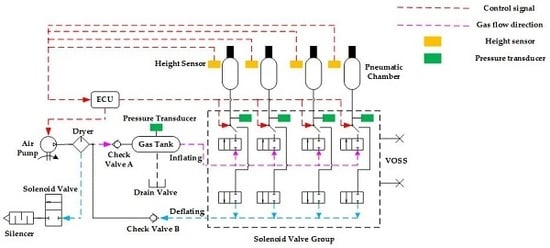Height Adjustment of Vehicles Based on a Static Equilibrium Position State Observation Algorithm †
Abstract
:1. Introduction
2. System Modeling
2.1. ECAS System
2.2. Model of Vehicle Dynamics
2.3. Model of Air Suspension
3. Control Strategy of Vehicle Height Regulation
3.1. The Establishment of State Observer
3.2. Unscented Kalman Filter Algorithm
3.3. Fuzzy Controller
4. Simulation
4.1. Paramaters of Model
4.2. Model Comparision
4.3. Model Simulation
4.3.1. Statics
4.3.2. Speed Control Bump
4.3.3. B Level Typical with Speed 90 km/h
5. Experiments
5.1. Model Verification
5.1.1. Air Suspension Model Verification
5.1.2. 7-DOF Vehicle Model Verification
5.1.3. UKF Algorithm Verification
5.2. Experimental Verification
5.2.1. Vehicle Is Static
5.2.2. Vehicle Is Running on the Road
6. Conclusions
Acknowledgments
Author Contributions
Conflicts of Interest
References
- Xiong, R.; Tian, J.P.; Mu, H.; Wang, C. A systematic model-based degradation behavior recognition and health monitor method of lithium-ion batteries. Appl. Energy 2017, 207, 367–378. [Google Scholar] [CrossRef]
- Yu, Q.; Xiong, R.; Lin, C.; Shen, W.X.; Deng, J.J. Lithium-ion Battery Parameters and State-of-Charge Joint Estimation Based on H infinity and Unscented Kalman Filters. IEEE Trans. Veh. Technol. 2017, 66, 8693–8701. [Google Scholar] [CrossRef]
- Chen, C.; Xiong, R.; Shen, W. A lithium-ion battery-in-the-loop approach to test and validate multi-scale dual H infinity filters for state of charge and capacity estimation. IEEE Trans. Power Electron. 2018, 33, 332–342. [Google Scholar] [CrossRef]
- Xiong, R.; Cao, J.Y.; Yu, Q.; He, H.; Sun, F.C. Critical review on the battery state of charge estimation methods for electric vehicles. IEEE Access 2017, 6, 1832–1843. [Google Scholar] [CrossRef]
- Woodrooffe, J. Heavy Truck Suspension Dynamics: Methods for Evaluating Suspension Road Friendliness and Ride Quality; SAE: Warrendale, PA, USA, 1996. [Google Scholar] [CrossRef]
- Bao, W.; Chen, L.P.; Zhang, Y.Q. Fuzzy Adaptive sliding mode controller for an air spring active suspension. Int. J. Automot. Technol. 2012, 13, 1057–1065. [Google Scholar] [CrossRef]
- Niea, S.; Zhuang, Y.; Liu, W.; Chen, W. A Semi-active suspension control algorithm for vehicle comprehensive vertical dynamics performance. Veh. Syst. Dyn. 2017, 55, 1099–1122. [Google Scholar] [CrossRef]
- Schonfeld, K.; Geiger, H.; Hesse, K. Electronically Controlled Air Suspension (ECAS) for Commercial Vehicles; SAE: Warrendale, PA, USA, 1991. [Google Scholar] [CrossRef]
- Nagai, M.; Moran, A.; Tamura, Y.; Koizumi, S. Identification and control of non-linear active pneumatic suspension for rail way vehicles using neural networks. Control Eng. Pract. 1997, 5, 1137–1144. [Google Scholar] [CrossRef]
- Meller, T. Self-Energizing Leveling Systems Their Progress in Development and Application; SAE: Warrendale, PA, USA, 1999; pp. 42–45. [Google Scholar]
- Chen, Y.; Chen, L.; Wang, R.; Xu, X.; Shen, Y.; Liu, Y. Modeling and test on height adjustment system of electrically-controlled air suspension for agricultural vehicles. Int. J. Agric. Biol. Eng. 2016, 9, 40–47. [Google Scholar]
- Kyuhyun, S.; Lee, H.; Ji, W.; Choi, C.; Hwang, S. Effectiveness evaluation of Hydro-Pneumatic and Semi-active Cab suspension for the Improvement of ride comfort of agricultural tractors. J. Terramech. 2017, 69, 23–32. [Google Scholar]
- Sayyaadi, H.; Shokouhi, N. New dynamics model for rail vehicles and optimizing air suspension parameters using GA. Sci. Iran. 2009, 16, 496–512. [Google Scholar]
- Alonso, A.; Giménez, J.G.; Vinolas, J. Air suspension characterisation and effectiveness of a Variable Area Orifice. Veh. Syst. Dyn. 2010, 48, 271–286. [Google Scholar] [CrossRef]
- Nakajima, T.; Shimokawa, Y.; Mizuno, M. Air suspension system model coupled with leveling and differential pressure valves for railroad vehicle dynamics simulation. J. Comput. Nonlinear Dyn. 2014, 9, 149–155. [Google Scholar] [CrossRef]
- Löcken, F.; Welsch, M. The dynamic characteristic and hysteresis effect of an Air Spring. Int. J. Appl. Mech. Eng. 2015, 20, 127–145. [Google Scholar] [CrossRef]
- Zhu, H.; Yang, J.; Zhang, Y.; Feng, X. A novel Air Spring Dynamic Model with Pneumatic Thermodynamics, Effective Friction and Viscoelastic Damping. J. Sound Vib. 2017, 408, 87–104. [Google Scholar] [CrossRef]
- Such, Y.; Kumaki, S. Study on curving characteristic of enhance vehicle stability. Int. J. Veh. Des. 2000, 23, 124–144. [Google Scholar]
- Lee, I.; Park, J.; Shin, M.; Jang, J. Study of failure examples of automotive electronic control suspension system including cases with wiring disconnection and air leakage. J. Korean Soc. Tribol. Lubr. Eng. 2013, 29, 180–185. [Google Scholar] [CrossRef]
- Prabu, K.; Jancirani, J.; John, D. Vibration control of air suspension system using PID controller. J. Vibroeng. 2013, 15, 132–138. [Google Scholar]
- Xiong, R.; Yu, Q.; Wang, L.Y.; Lin, C. A novel method to obtain the open circuit voltage for the state of charge of lithium ion batteries in electric vehicles by using H infinity filter. Appl. Energy 2017, 207, 341–348. [Google Scholar] [CrossRef]
- Xu, X.; Chen, L.; Sun, L.; Sun, X. Dynamic ride height adjusting controller of ECAS vehicle with random road disturbances. Math Probl. Eng. 2013, 2013. [Google Scholar] [CrossRef]
- Xu, X.; Zhou, K.; Zou, N.; Jiang, H.; Cui, X. Hierarchical control of ride height system for electronically controlled air suspension based on variable structure and fuzzy control theory. Chin. J. Mech. Eng. 2015, 28, 945–953. [Google Scholar] [CrossRef]
- Sun, X.; Chen, L.; Wang, S.; Xu, X. Vehicle height control of electronic air suspension system based on mixed logical dynamical modelling. Sci. China Technol. Sci. 2015, 58, 1894–1904. [Google Scholar] [CrossRef]
- Sun, X.; Cai, Y.; Wang, S.; Liu, Y.; Chen, L. A hybrid approach to modeling and control of vehicle height for electronically controlled Air Suspension. Chin. J. Mech. Eng. 2016, 29, 152–162. [Google Scholar] [CrossRef]
- Xiong, R.; Cao, J.Y.; Yu, Q. Reinforcement learning-based real-time power management for hybrid energy storage system in the plug-in hybrid electric vehicle. Appl. Energy 2018, 211, 538–548. [Google Scholar] [CrossRef]
- Sun, X.; Cai, Y.; Yuan, C.; Wang, S.; Chen, L. Vehicle height and leveling control of electronically controlled air suspension using mixed logical dynamical approach. Sci. China Technol. Sci. 2016, 59, 1814–1824. [Google Scholar] [CrossRef]
- Kim, H.; Lee, L. Fault-Tolerant Control Algorithm for a Four-Corner Closed-Loop Air Suspension System. IEEE. Trans. Ind. Electron. 2011, 58, 4866–4879. [Google Scholar] [CrossRef]
- Kim, H.; Lee, L. Model-based fault-tolerant control for an automotive air suspension control system. Proc. Inst. Mech. Eng. Part D J. Automob. Eng. 2008, 225, 1462–1480. [Google Scholar] [CrossRef]
- Kim, H.; Lee, L. Height and levelling control of automotive air suspension system using sliding mode approach. IEEE Trans. Veh. Technol. 2011, 60, 2027–2041. [Google Scholar]
- Peng, J.; He, H.; Feng, N. simulation research on an electric vehicle chassis system based on a collaborative control system. Energies 2013, 6, 312–328. [Google Scholar] [CrossRef]
- Wang, R.; Gu, F.; Robert, C.; Andrew, D. Modelling, testing and analysis of a regenerative hydraulic shock absorber system. Energies 2016, 9, 386. [Google Scholar] [CrossRef]
- Yao, E.; Wang, H.; Liu, L.; Xi, G. A novel constant-pressure pumped hydro combined with compressed air energy storage system. Energies 2015, 8, 154–171. [Google Scholar] [CrossRef]
- Jiang, H.; Qian, K.; Lai, Z. Study on Parameters Matching of Air Suspension with Adjustable Auxiliary Chamber and Full Vehicle. Appl. Mech. Mater. 2014, 577, 277–280. [Google Scholar] [CrossRef]
- Ren, H.; Zhao, Y.; Chen, S.; Liu, G. State observer based adaptive sliding mode control for semi-active suspension systems. J. Vibroeng. 2015, 17, 1464–1475. [Google Scholar]
- Xiong, R.; Zhang, Y.; He, H.; Zhou, X.; Michael, P. A double-scale, particle-filtering, energy state prediction algorithm for lithium-ion batteries. IEEE Trans. Ind. Electron. 2018, 65, 1526–1538. [Google Scholar] [CrossRef]
- Hajiyev, C.; Soken, H. Robust adaptive unscented Kalman filter for attitude estimation of pico satellites. Int. J. Adapt. Control. Signal Process. 2014, 28, 107–120. [Google Scholar] [CrossRef]
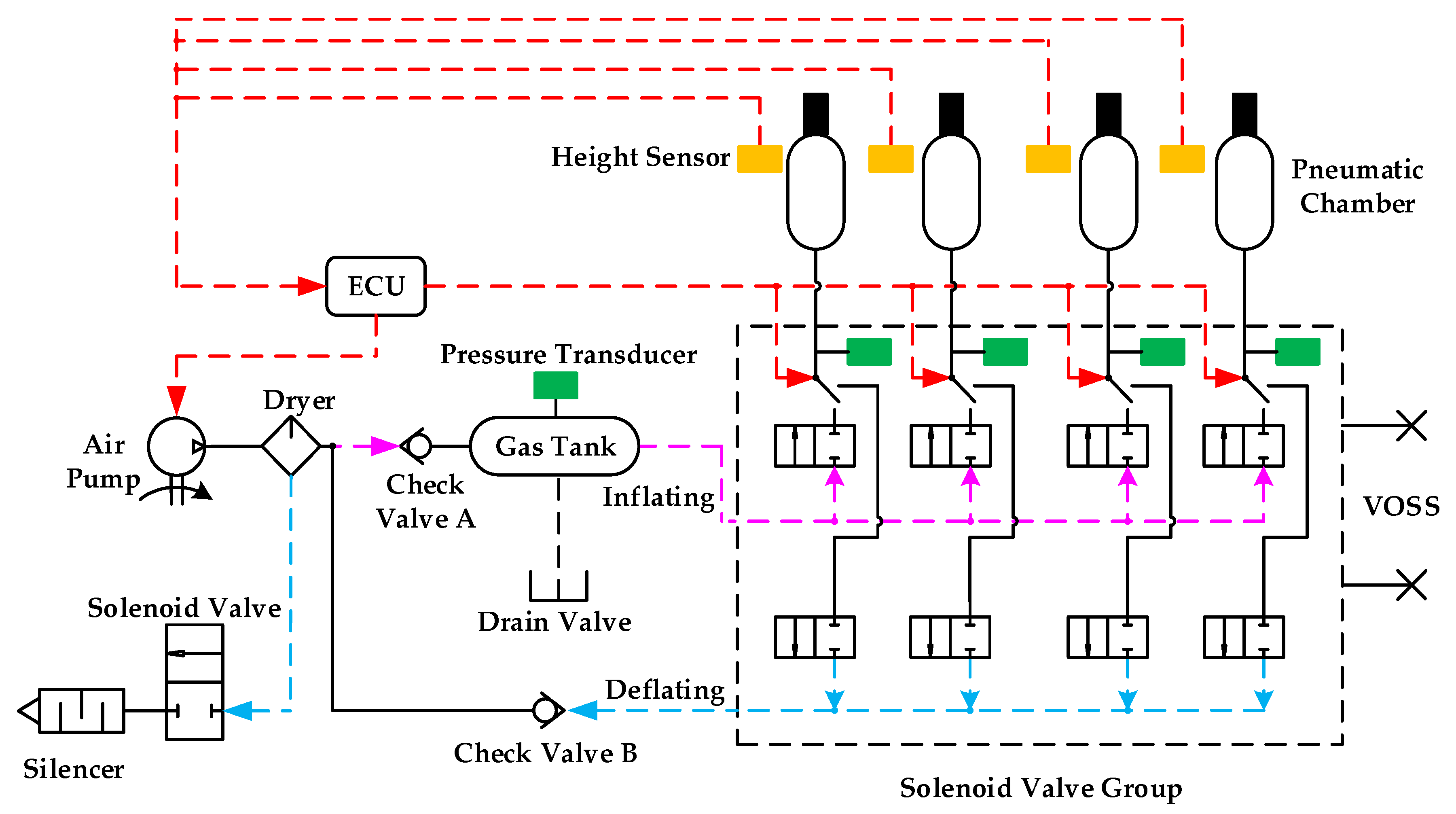
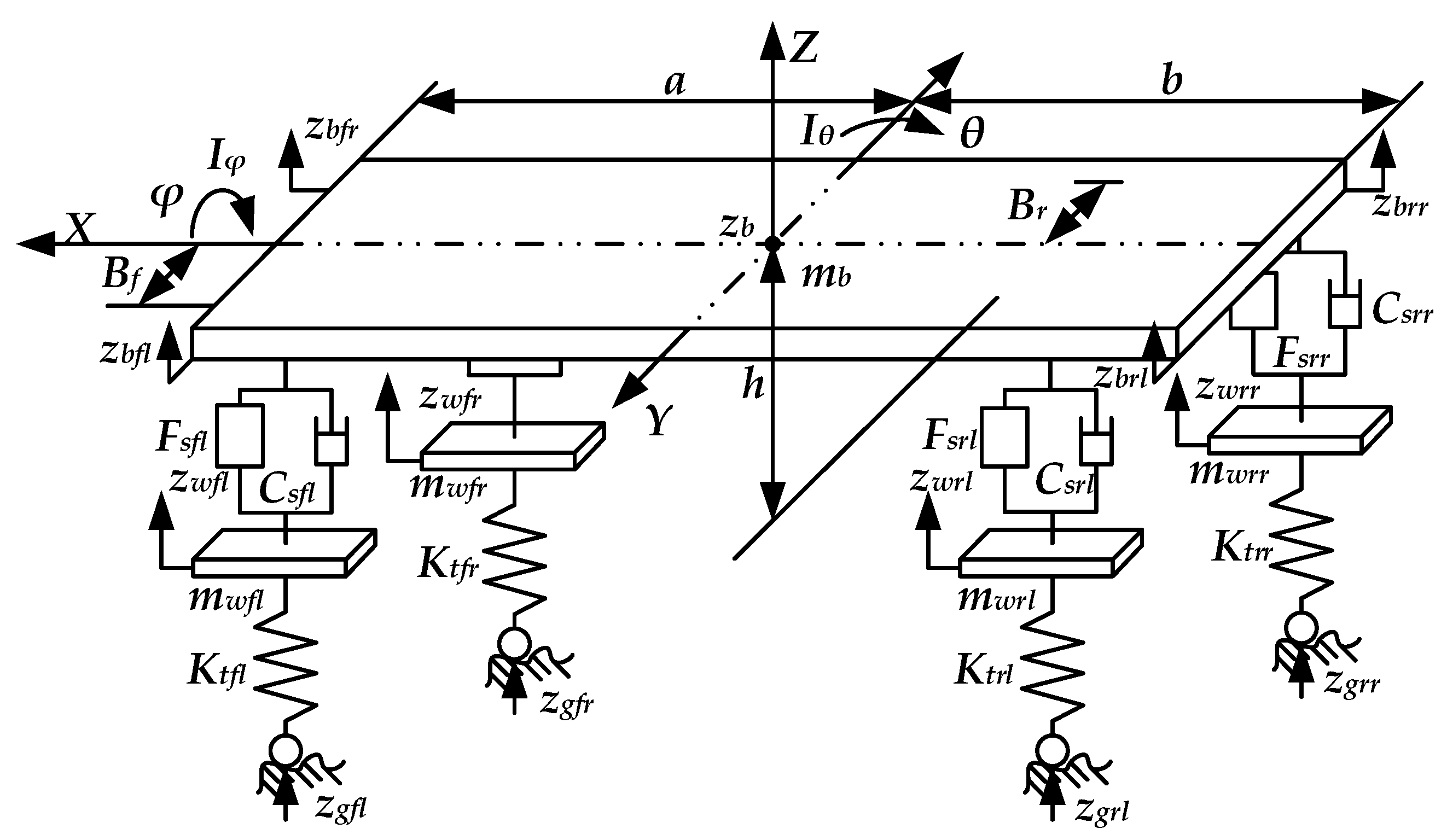
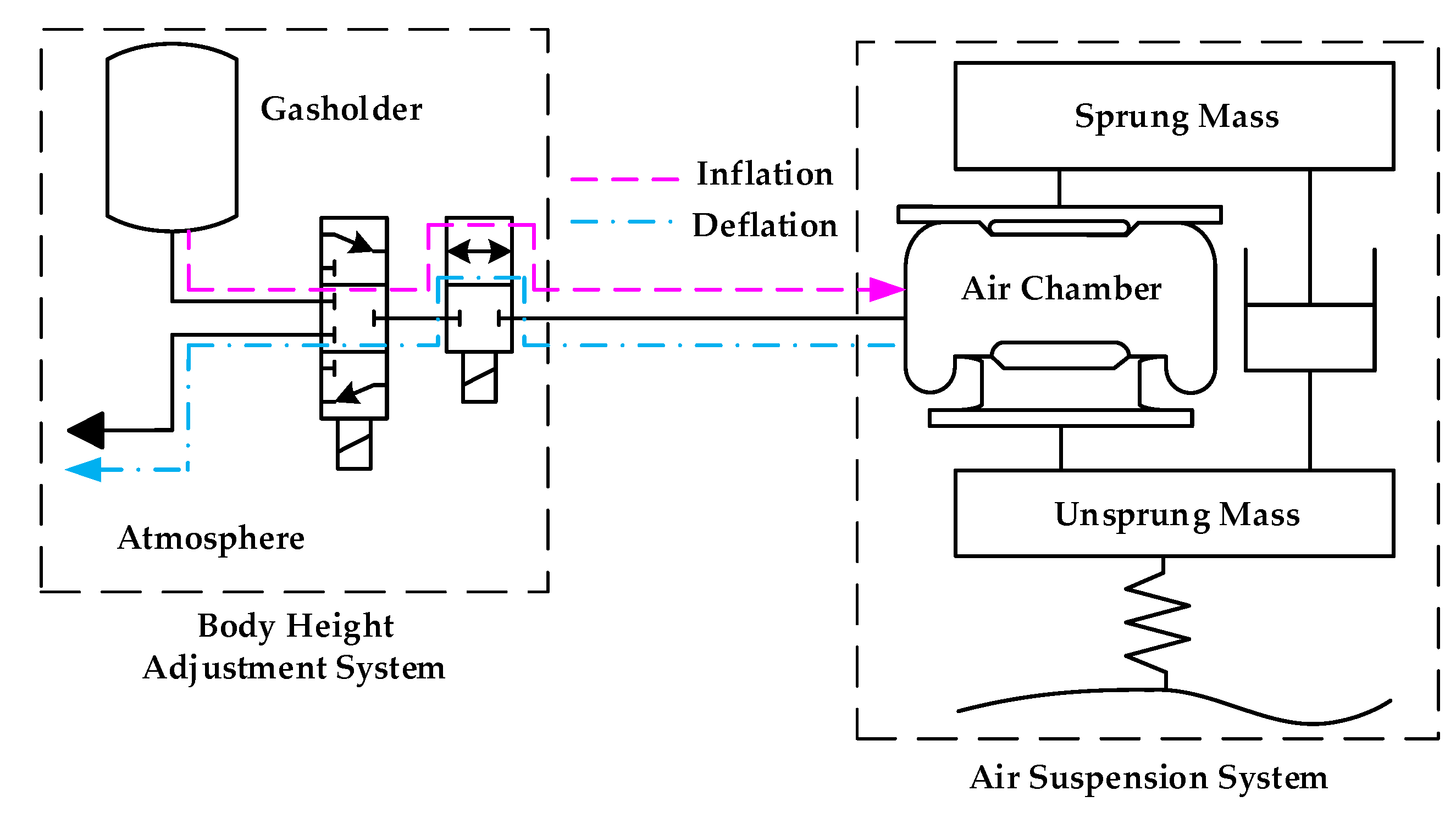
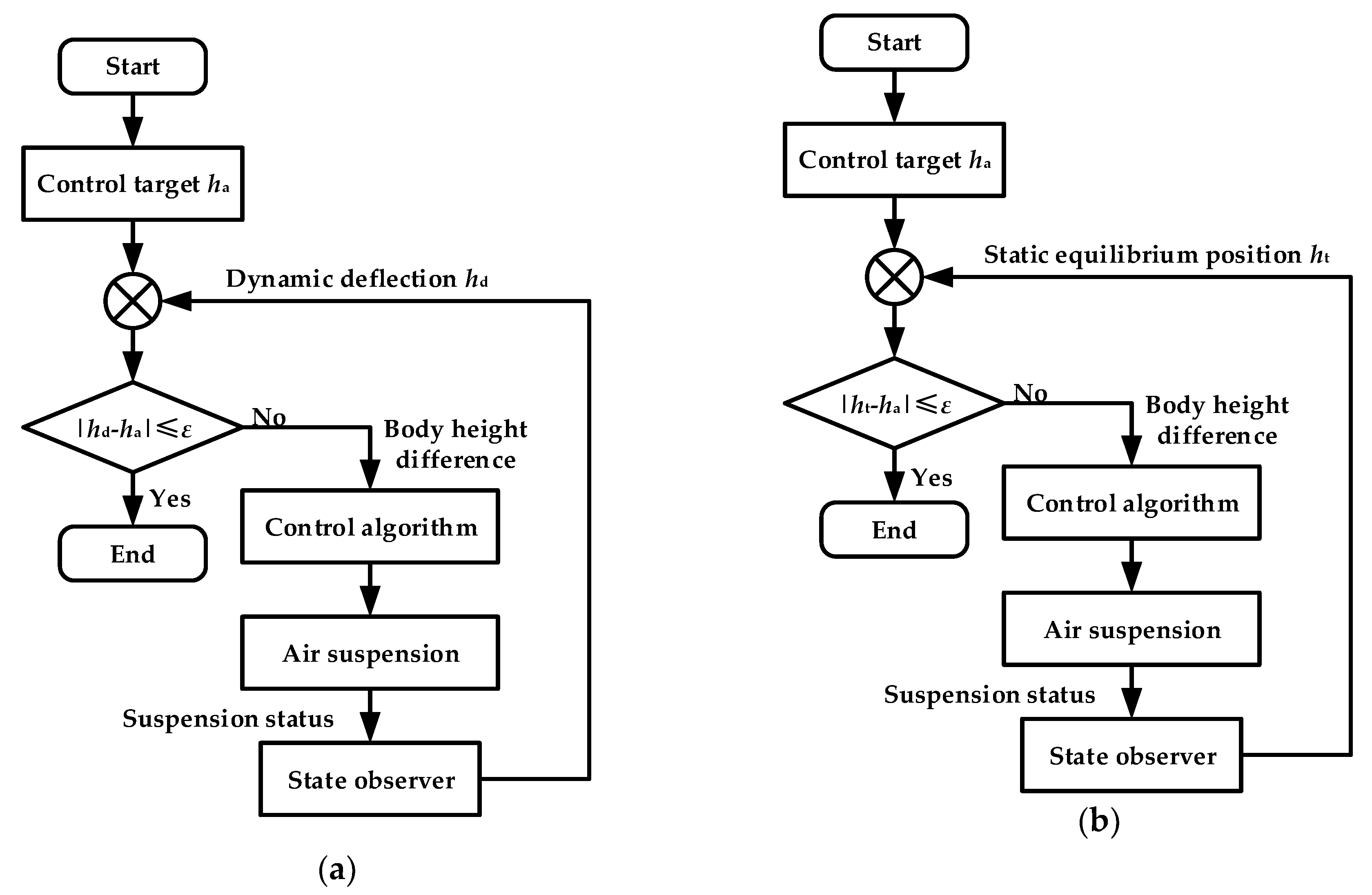
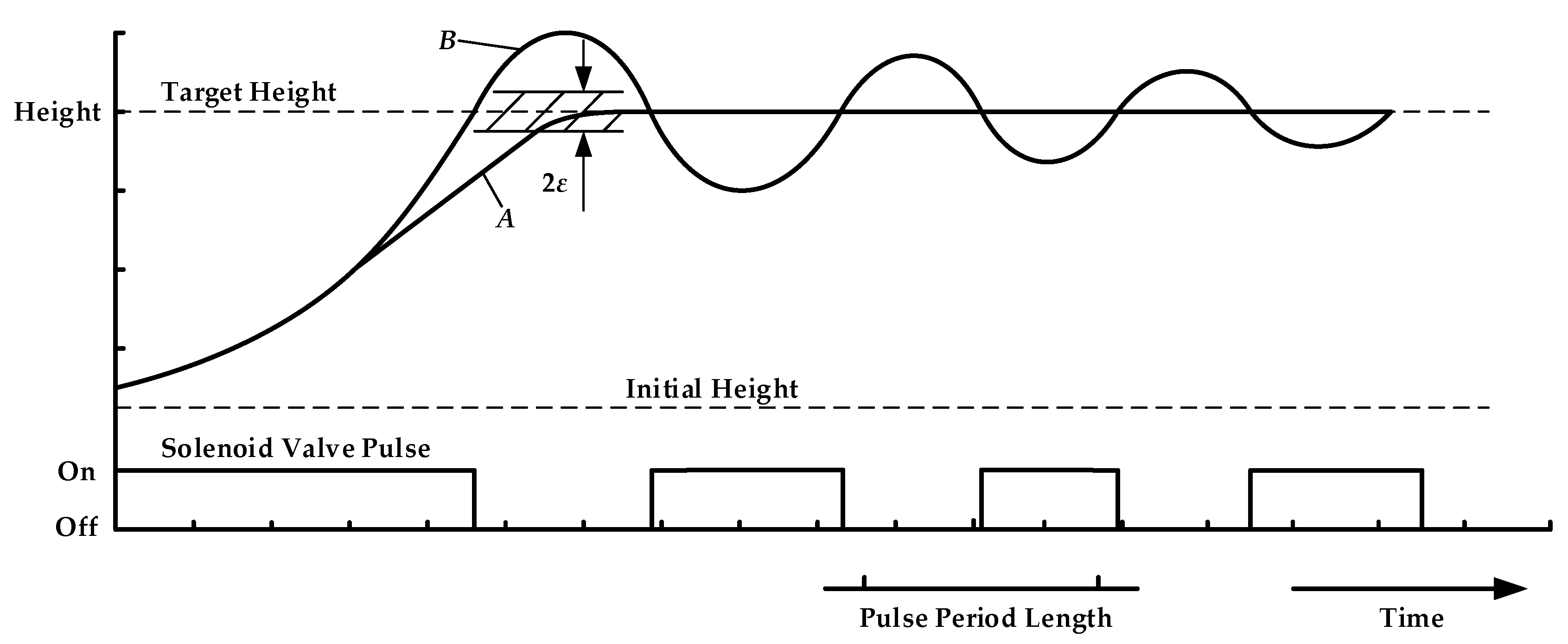
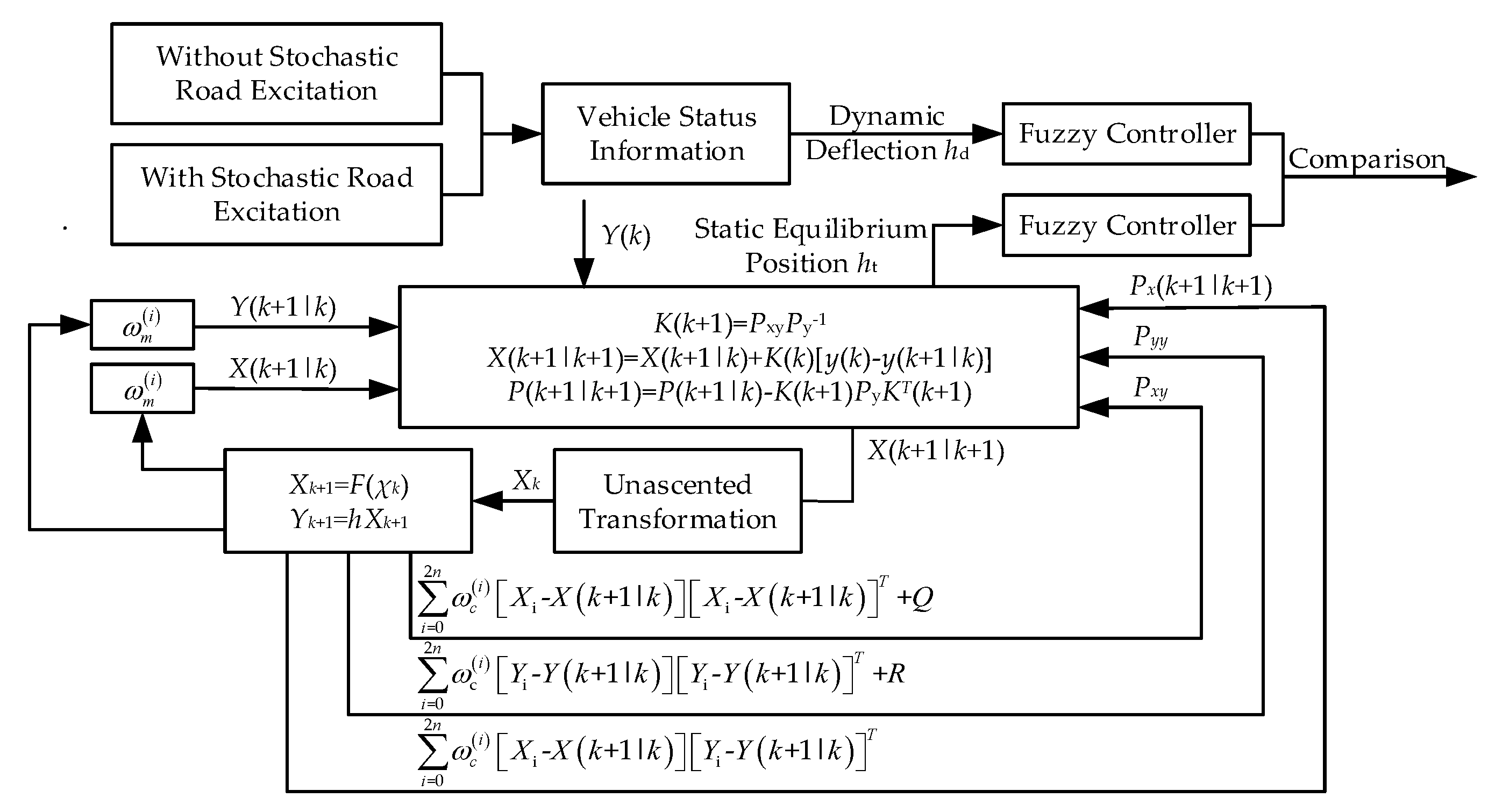


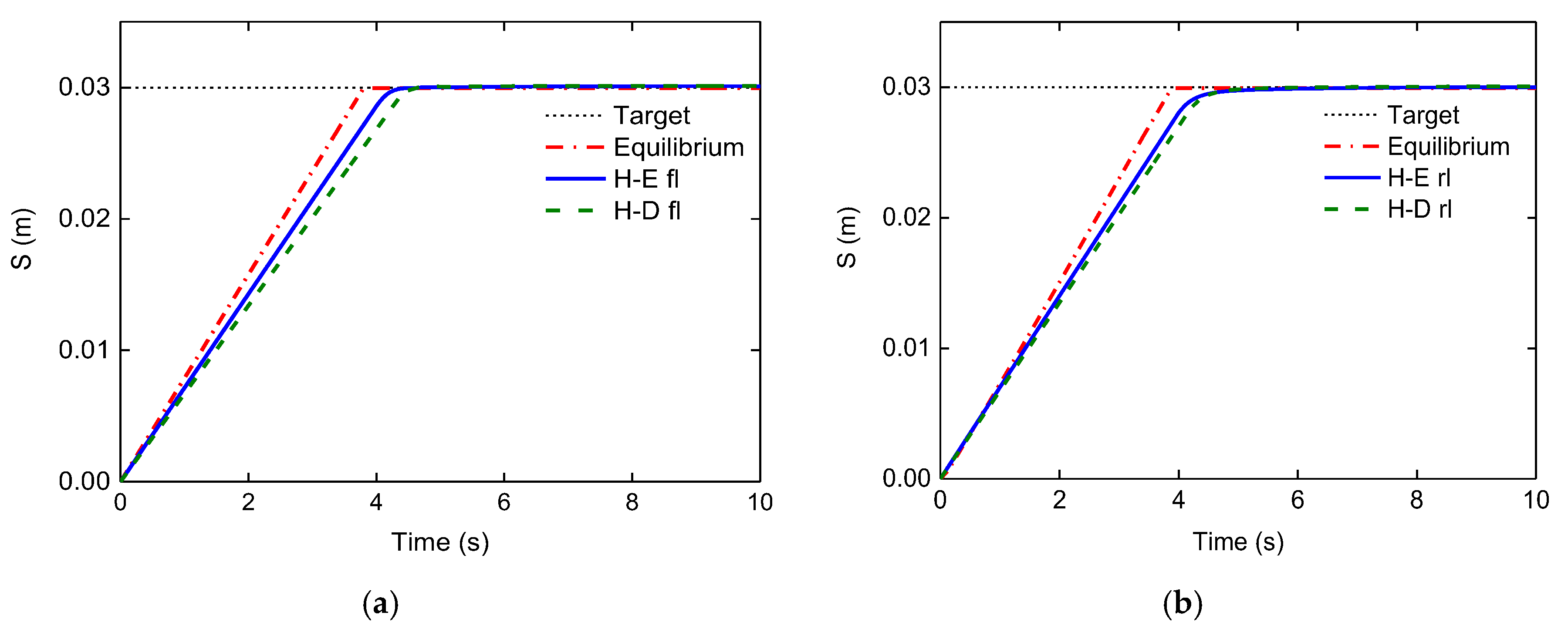
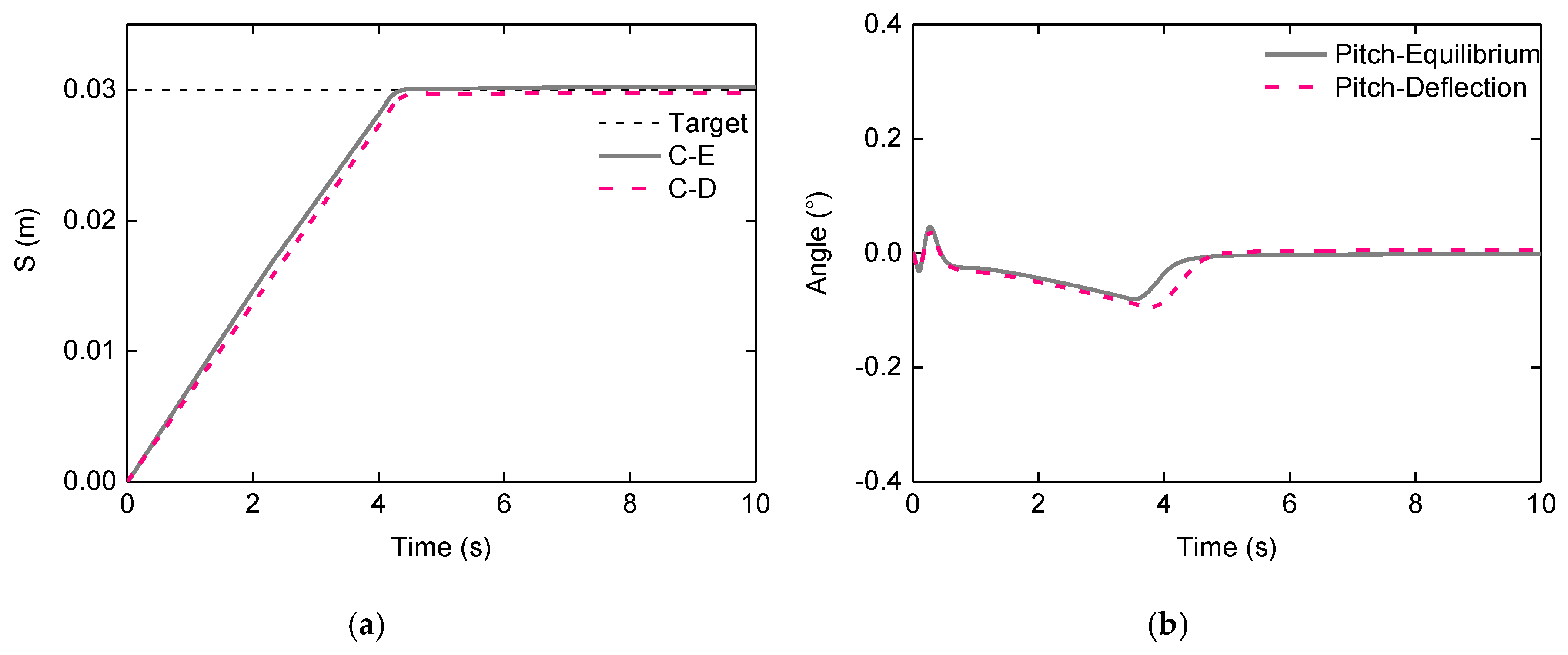
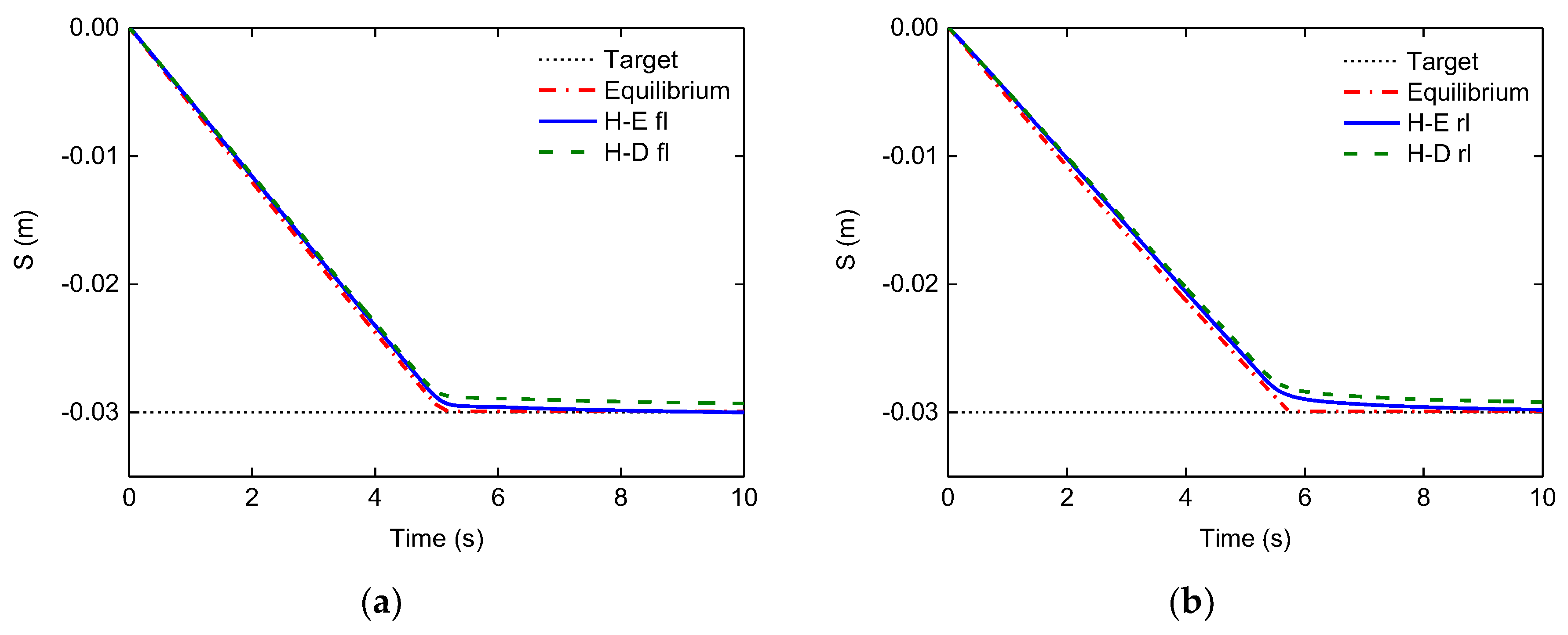
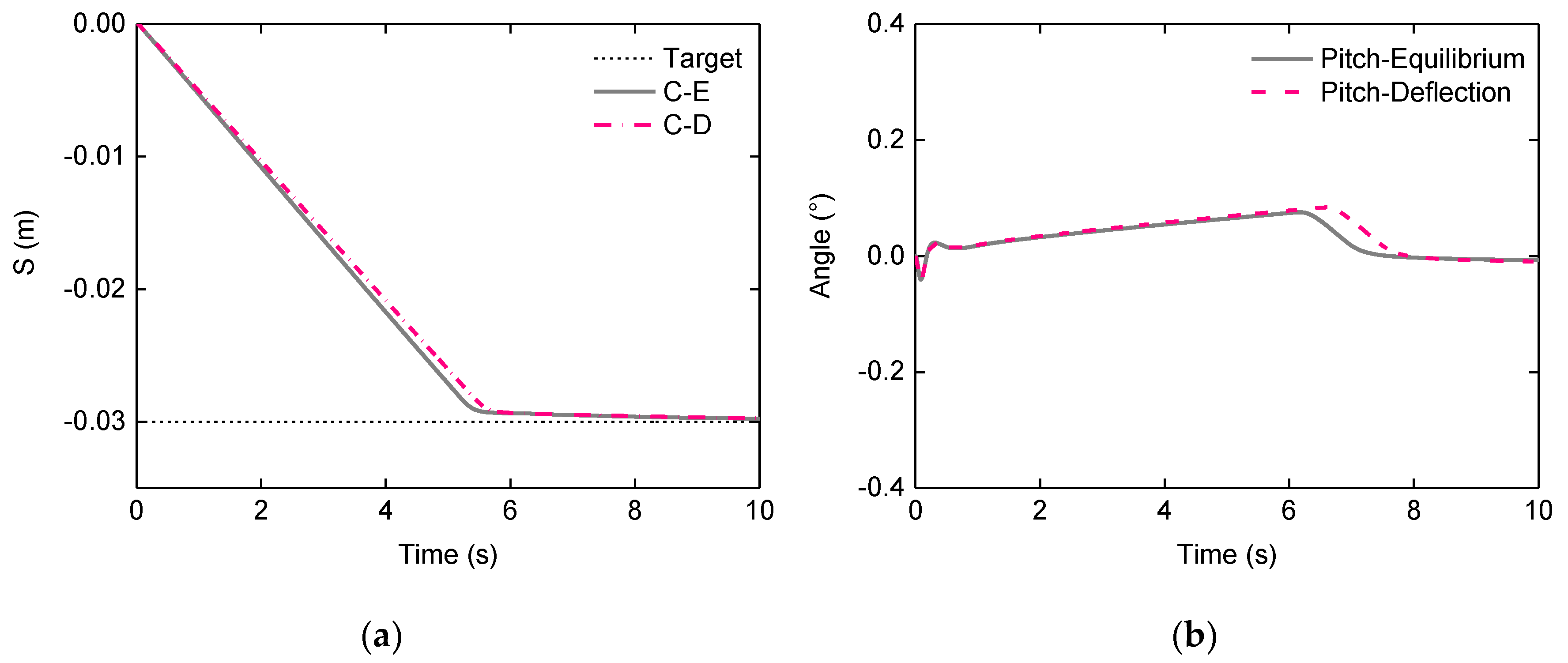

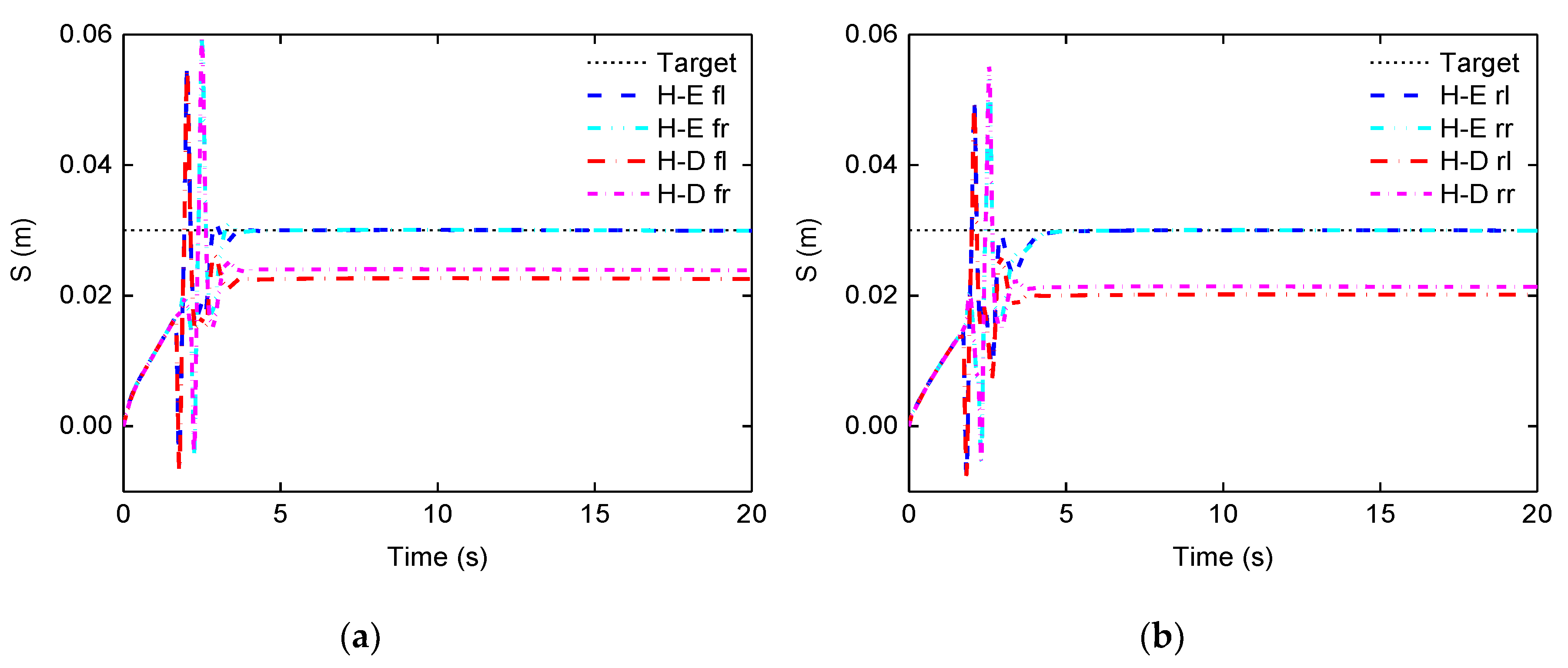
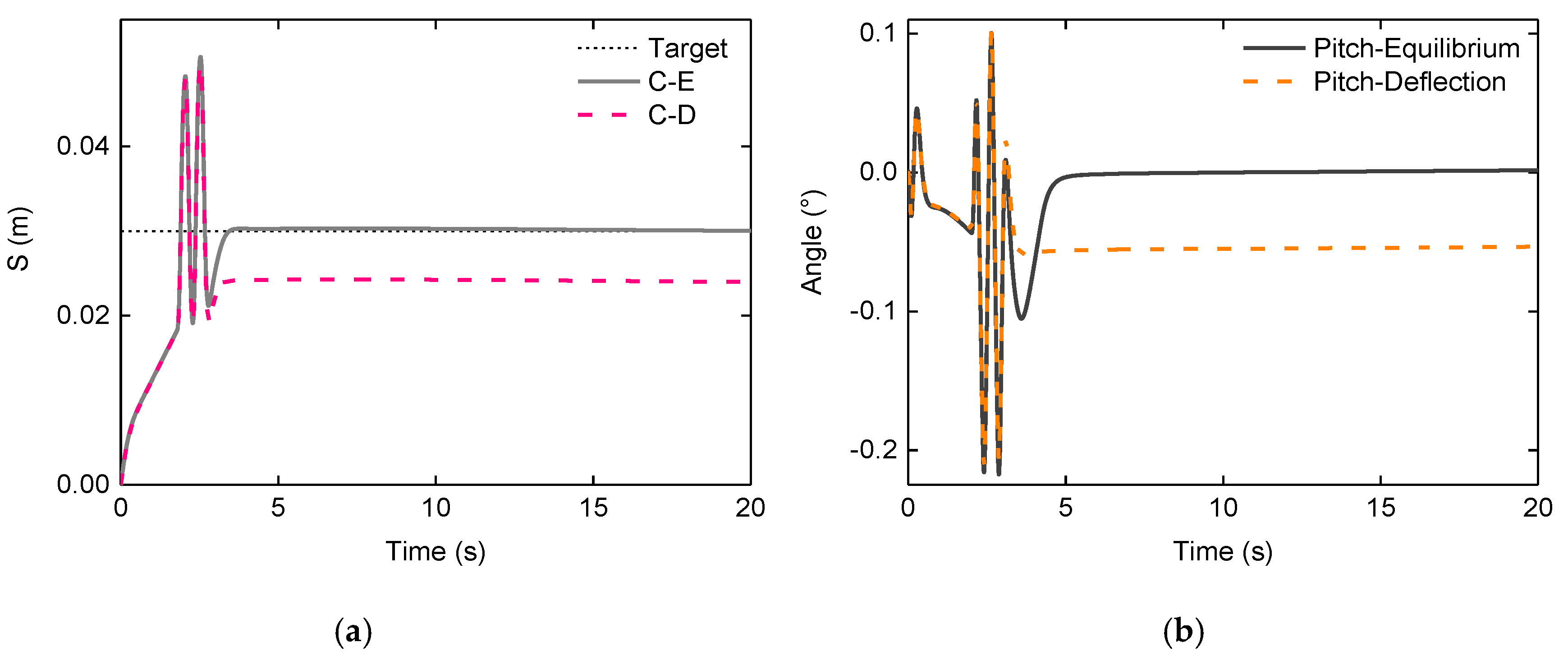
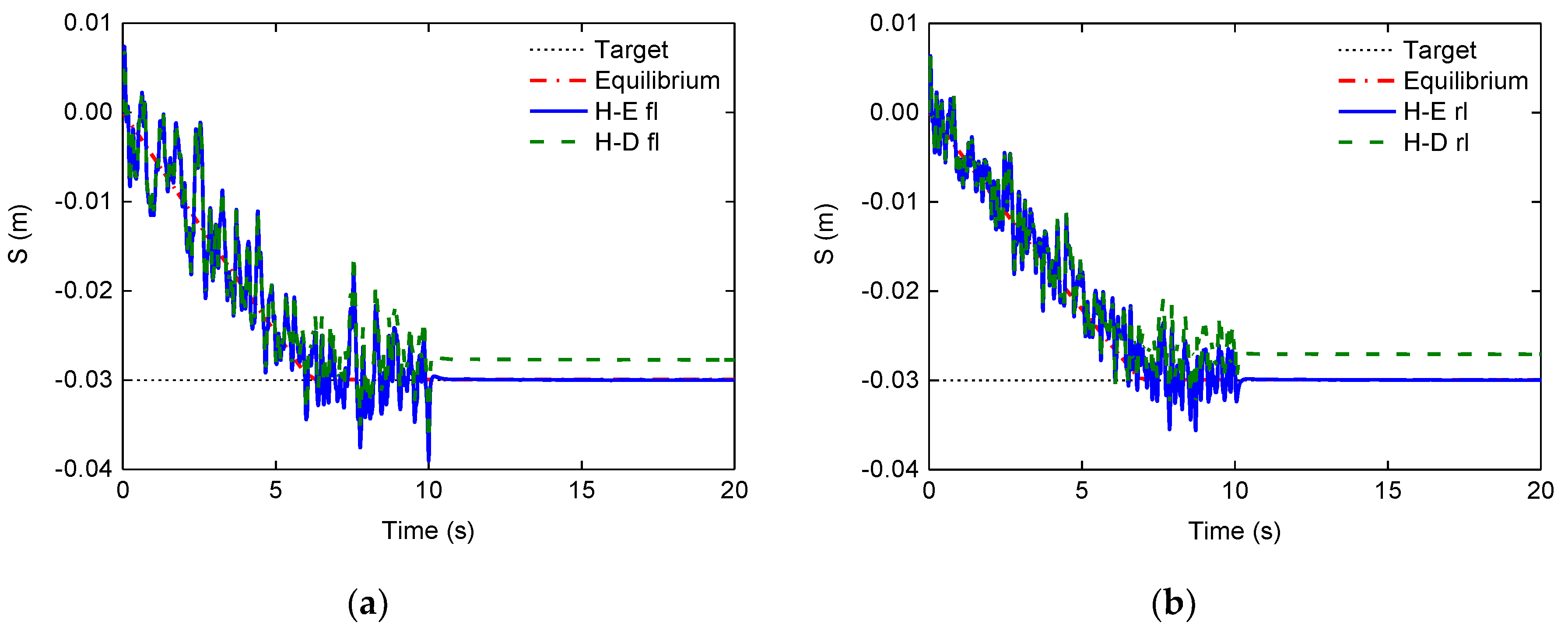
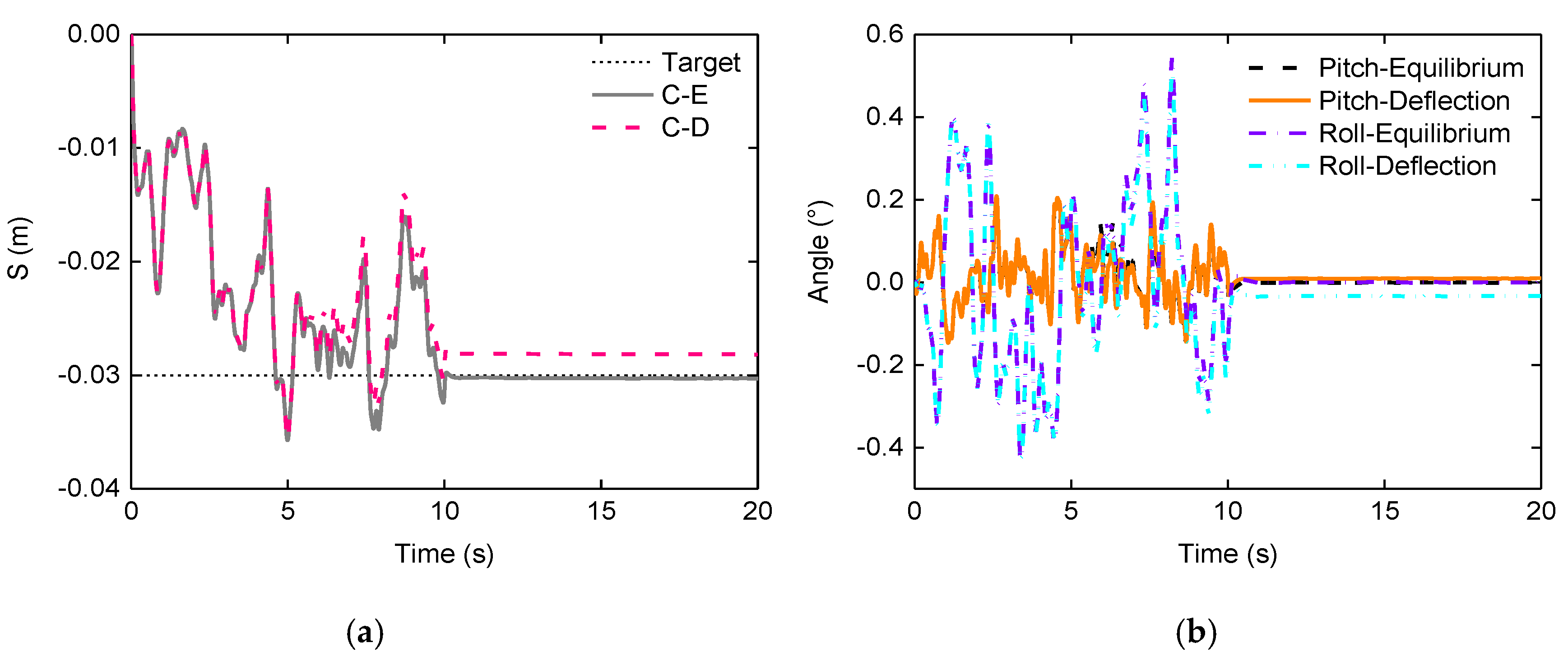
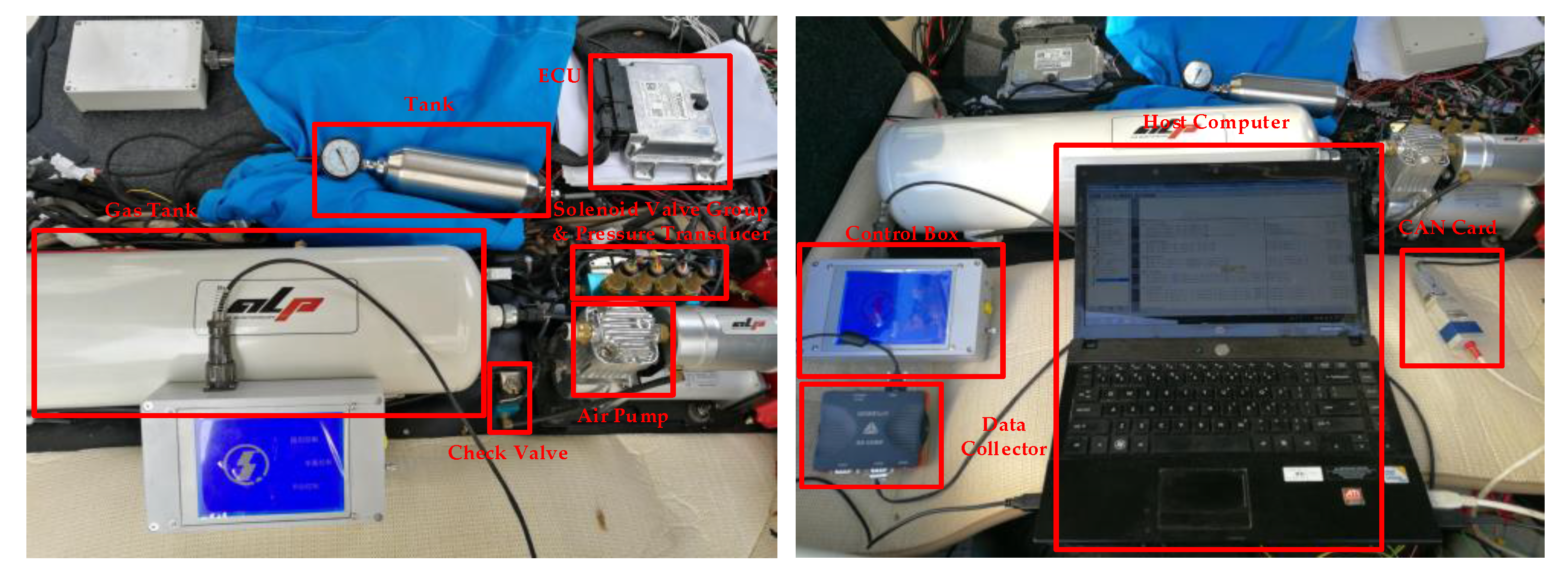
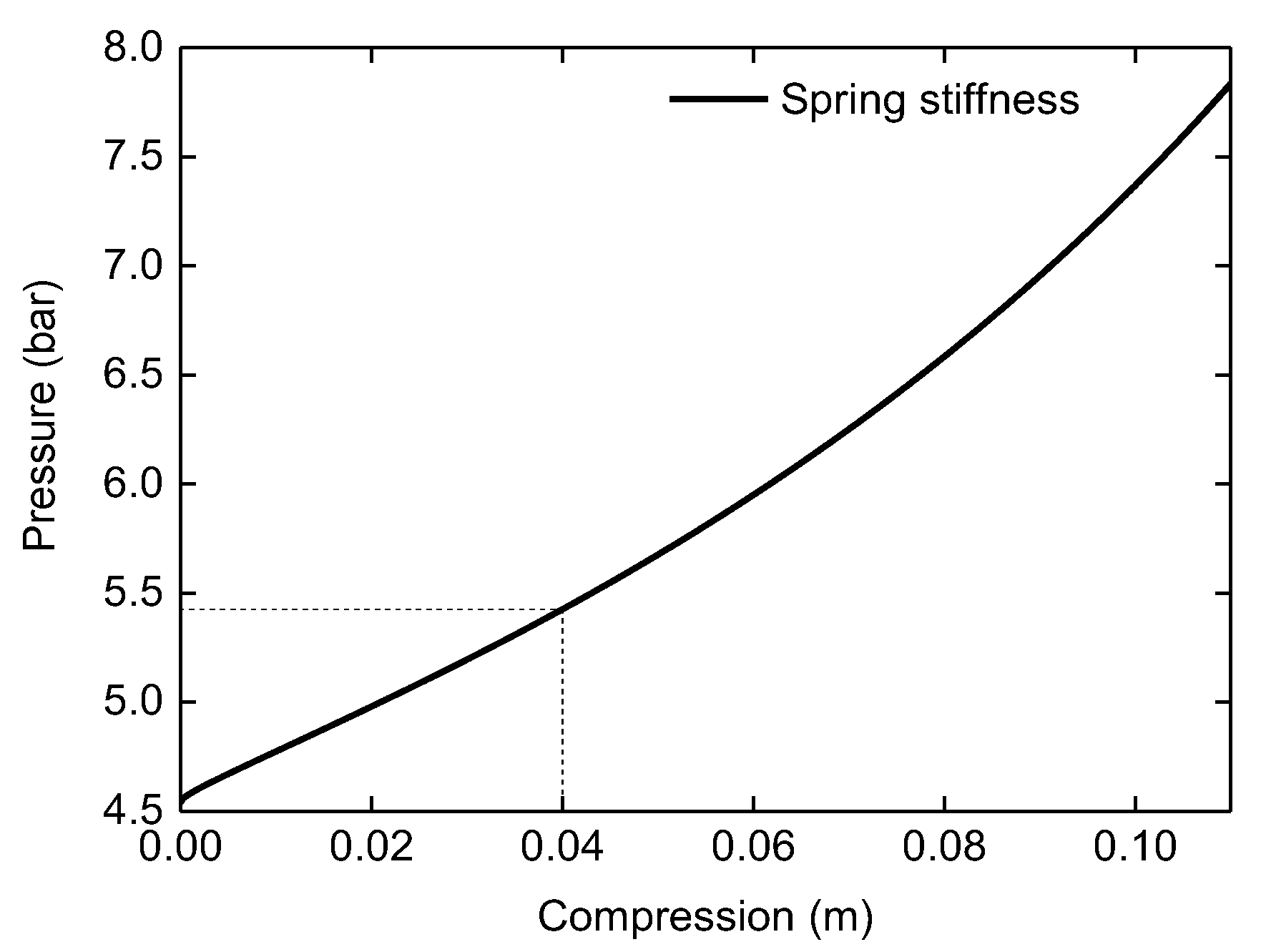

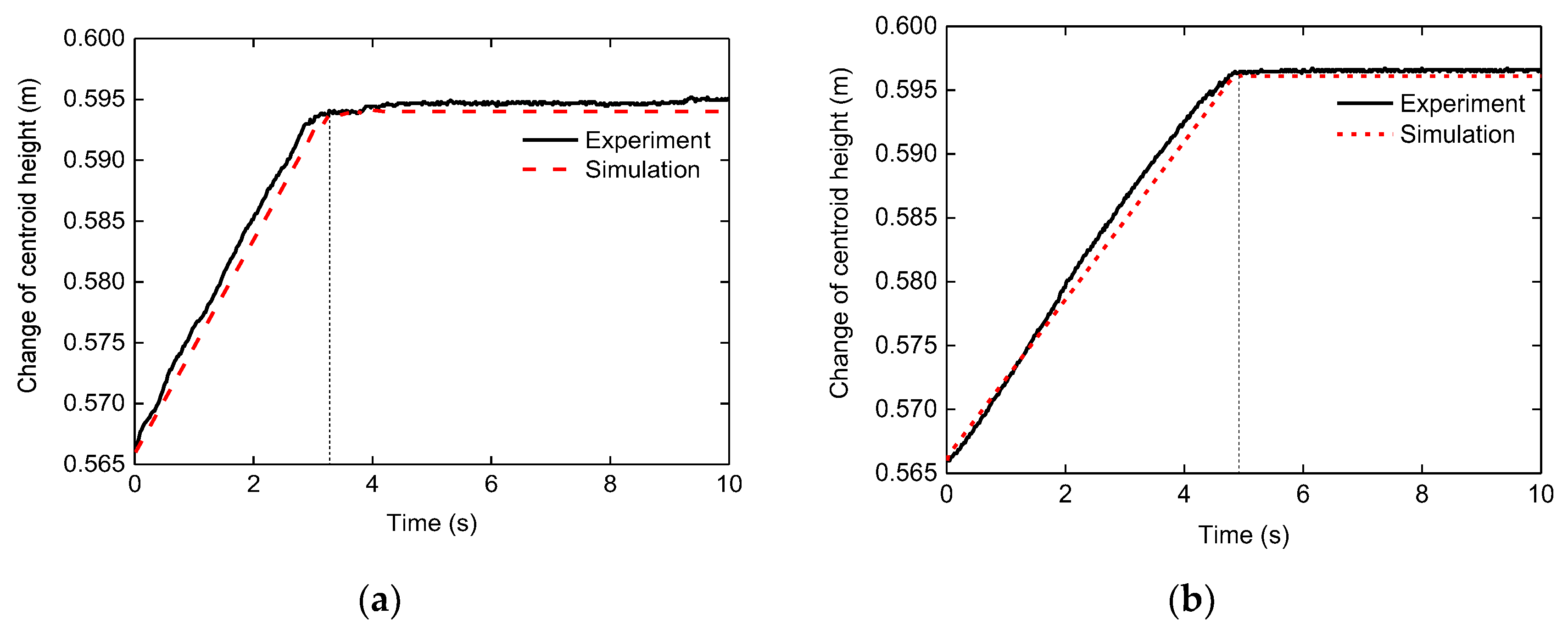
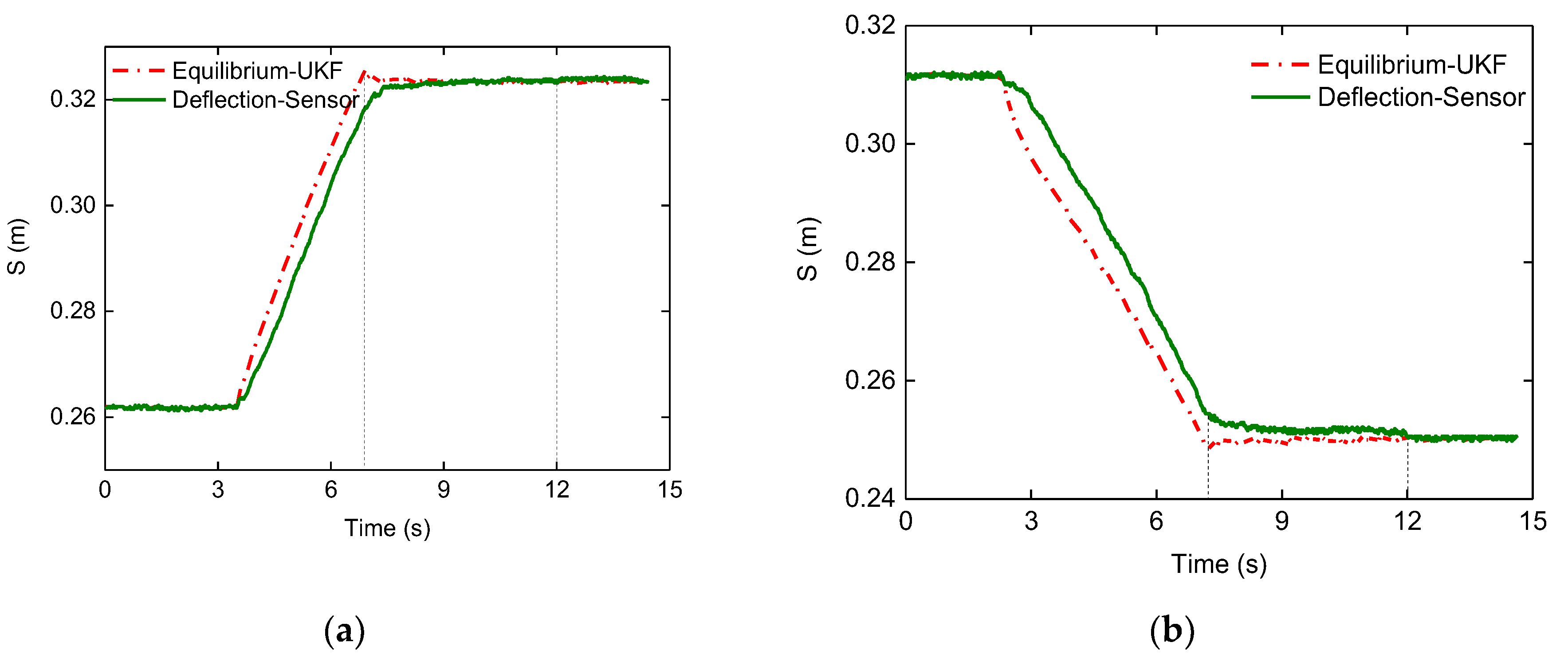
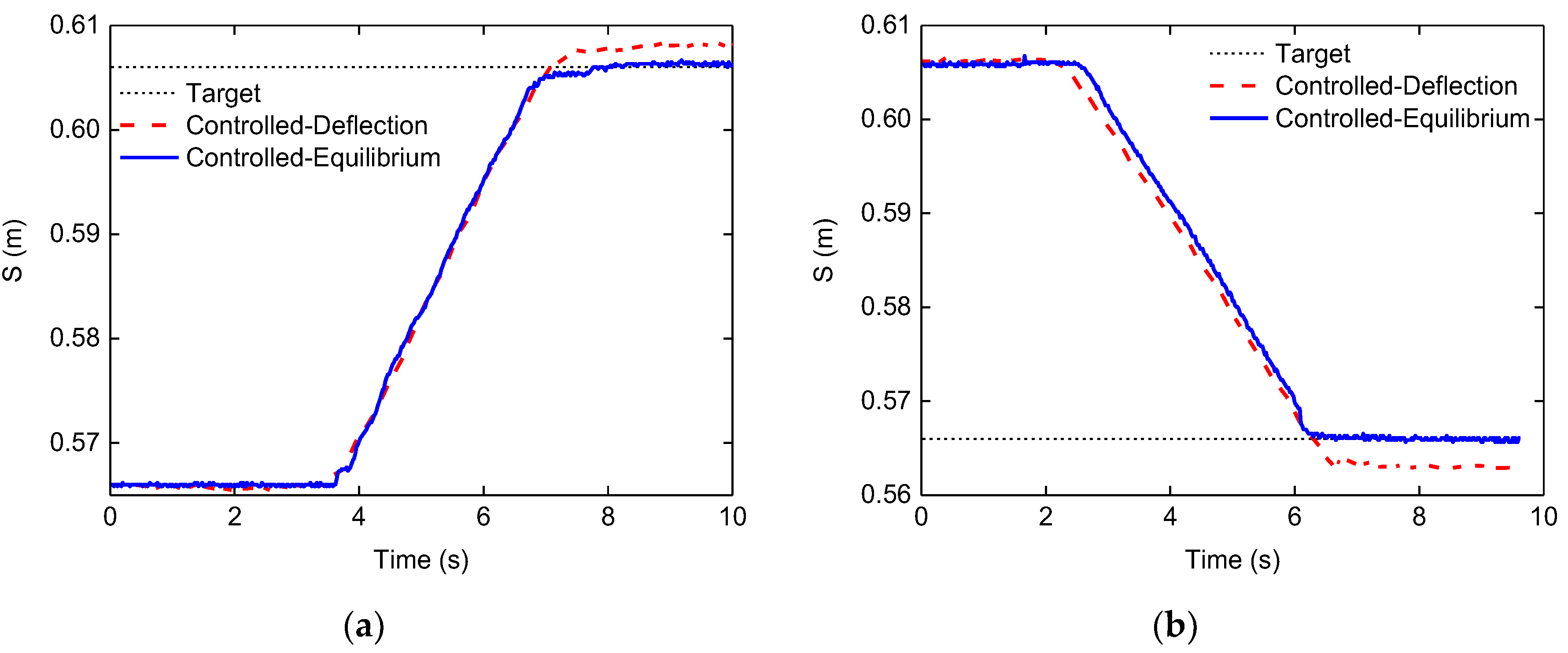
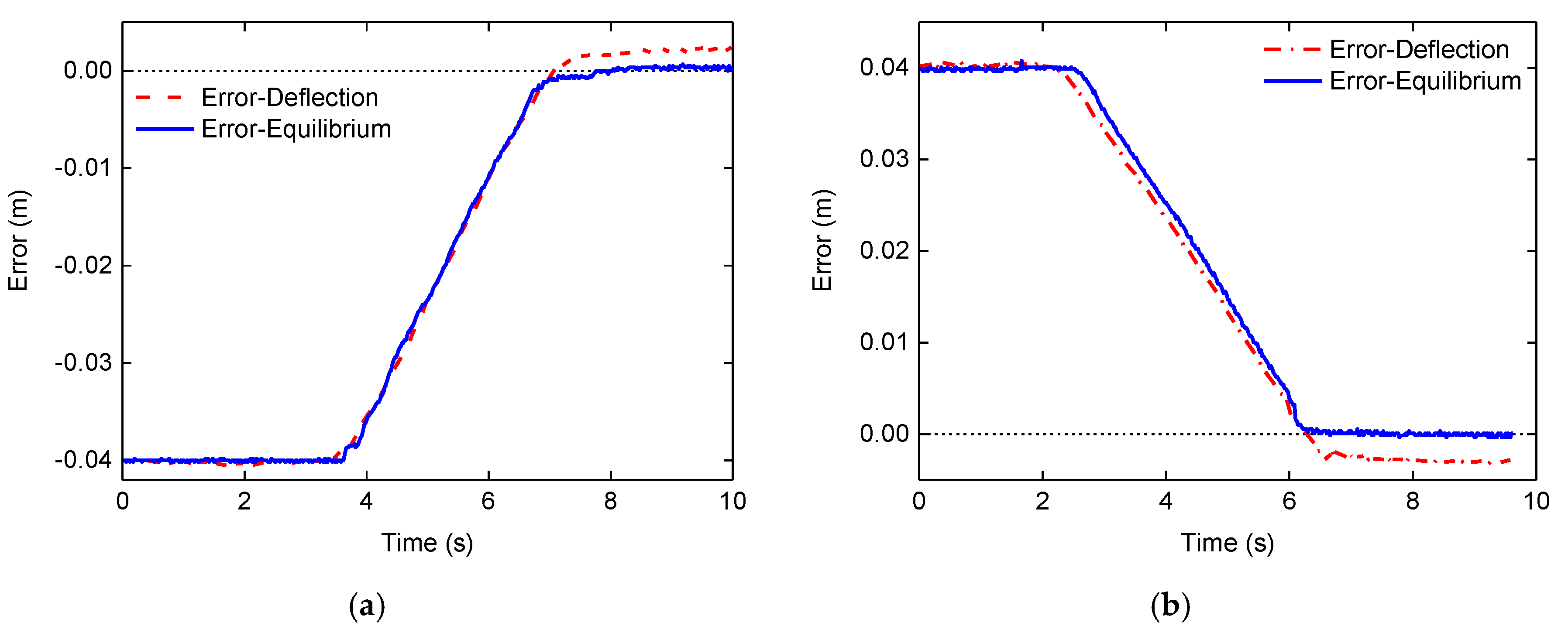
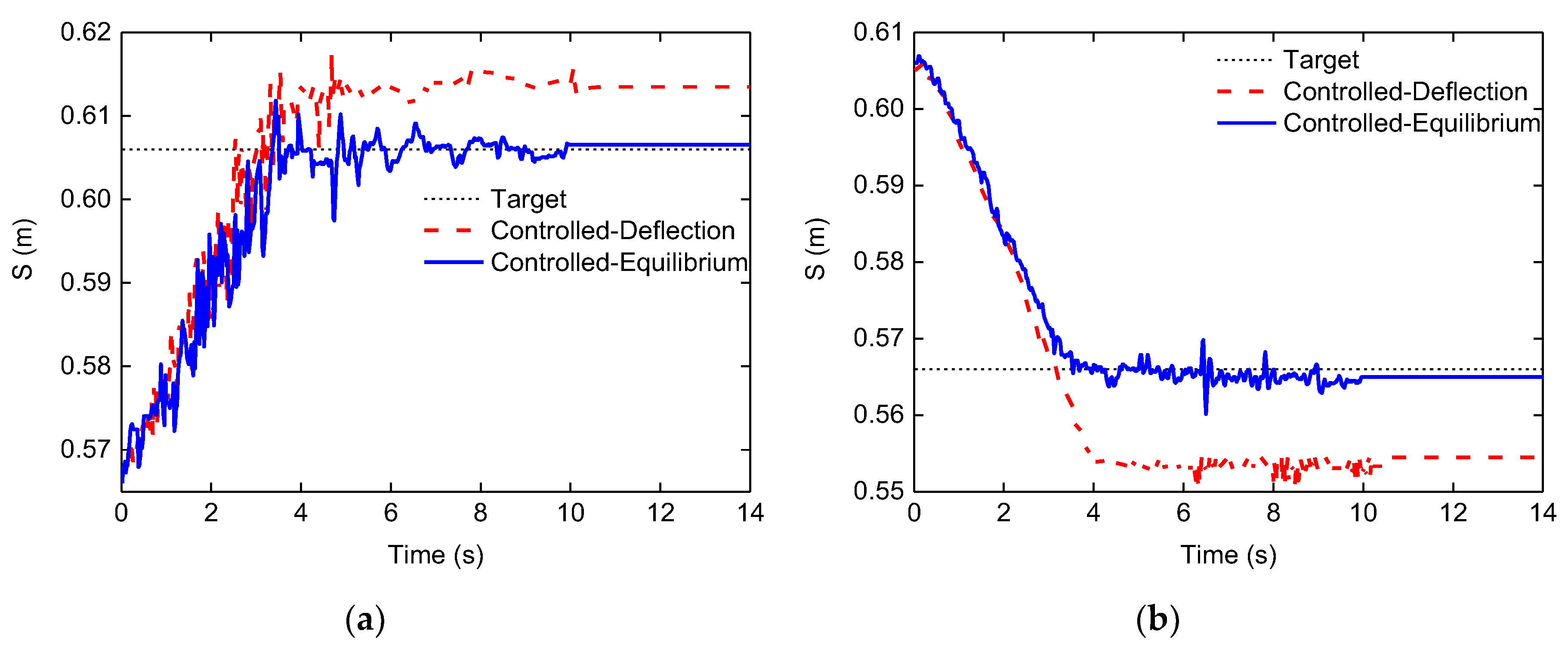
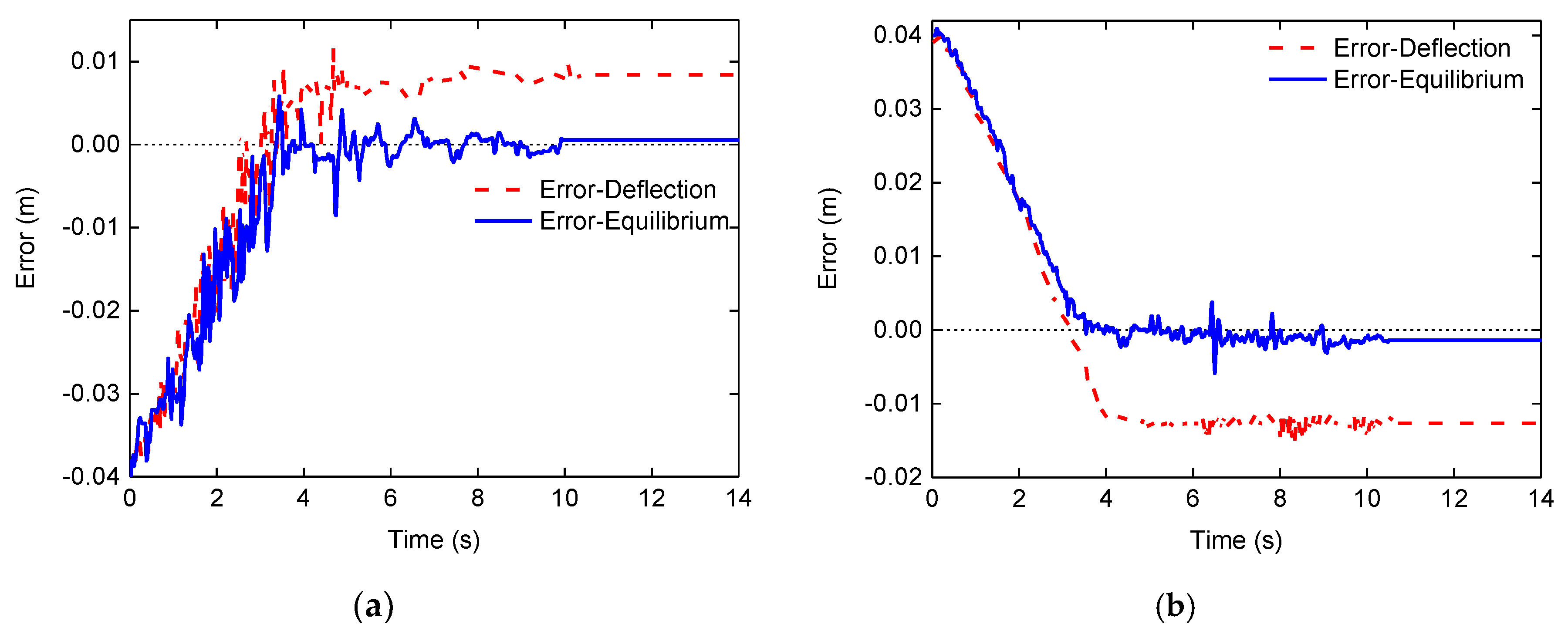

| DEE | XXS | XS | S | M | L | XL | XXL |
|---|---|---|---|---|---|---|---|
| NSS | NNS | NNS | NNS | NNS | NNS | NNS | NS |
| NS | NNS | NNS | NNS | NNS | NNS | NS | NS |
| N | NNS | NS | NS | S | M | B | PB |
| Z | S | S | M | B | PB | PB | PPB |
| P | S | M | B | B | PB | PPB | PPB |
| PB | M | B | B | PB | PPB | PPB | PPB |
| PPB | B | PB | PB | PPB | PPB | PPB | PPB |
| Parameters | Value | Parameters | Value |
|---|---|---|---|
| mb | 1000 kg | Cs | 5 kNs/m |
| mt | 42 kg | Kt | 232 kN/m |
| a | 1.05 m | A | 78.54 cm2 |
| b | 1.6 m | Ae | 3.14 mm2 |
| h | 0.566 m | L | −60 ~ 50 mm |
| Iθ | 2566.29 kg·m2 | R | 287 J/(kg K) |
| Iφ | 753.31 kg·m2 | D | 0.1 m |
| B | 1.5 m | g | 9.81 m/s2 |
© 2018 by the authors. Licensee MDPI, Basel, Switzerland. This article is an open access article distributed under the terms and conditions of the Creative Commons Attribution (CC BY) license (http://creativecommons.org/licenses/by/4.0/).
Share and Cite
Gao, Z.; Chen, S.; Zhao, Y.; Nan, J. Height Adjustment of Vehicles Based on a Static Equilibrium Position State Observation Algorithm. Energies 2018, 11, 455. https://doi.org/10.3390/en11020455
Gao Z, Chen S, Zhao Y, Nan J. Height Adjustment of Vehicles Based on a Static Equilibrium Position State Observation Algorithm. Energies. 2018; 11(2):455. https://doi.org/10.3390/en11020455
Chicago/Turabian StyleGao, Zepeng, Sizhong Chen, Yuzhuang Zhao, and Jinrui Nan. 2018. "Height Adjustment of Vehicles Based on a Static Equilibrium Position State Observation Algorithm" Energies 11, no. 2: 455. https://doi.org/10.3390/en11020455



